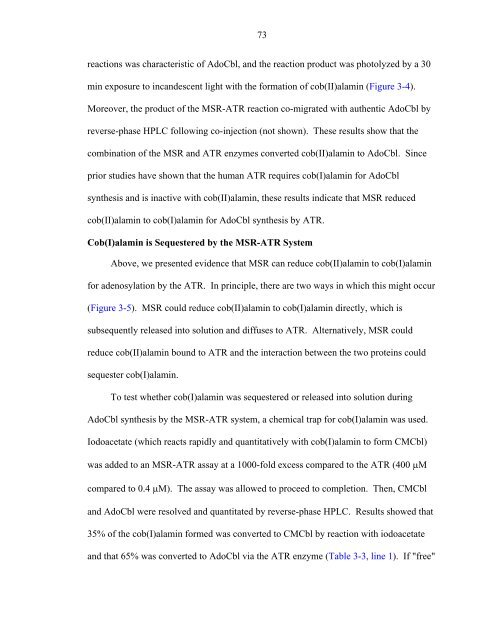B12 METABOLISM IN HUMANS By NICOLE AURORA LEAL A ...
B12 METABOLISM IN HUMANS By NICOLE AURORA LEAL A ...
B12 METABOLISM IN HUMANS By NICOLE AURORA LEAL A ...
You also want an ePaper? Increase the reach of your titles
YUMPU automatically turns print PDFs into web optimized ePapers that Google loves.
73<br />
reactions was characteristic of AdoCbl, and the reaction product was photolyzed by a 30<br />
min exposure to incandescent light with the formation of cob(II)alamin (Figure 3-4).<br />
Moreover, the product of the MSR-ATR reaction co-migrated with authentic AdoCbl by<br />
reverse-phase HPLC following co-injection (not shown). These results show that the<br />
combination of the MSR and ATR enzymes converted cob(II)alamin to AdoCbl. Since<br />
prior studies have shown that the human ATR requires cob(I)alamin for AdoCbl<br />
synthesis and is inactive with cob(II)alamin, these results indicate that MSR reduced<br />
cob(II)alamin to cob(I)alamin for AdoCbl synthesis by ATR.<br />
Cob(I)alamin is Sequestered by the MSR-ATR System<br />
Above, we presented evidence that MSR can reduce cob(II)alamin to cob(I)alamin<br />
for adenosylation by the ATR. In principle, there are two ways in which this might occur<br />
(Figure 3-5). MSR could reduce cob(II)alamin to cob(I)alamin directly, which is<br />
subsequently released into solution and diffuses to ATR. Alternatively, MSR could<br />
reduce cob(II)alamin bound to ATR and the interaction between the two proteins could<br />
sequester cob(I)alamin.<br />
To test whether cob(I)alamin was sequestered or released into solution during<br />
AdoCbl synthesis by the MSR-ATR system, a chemical trap for cob(I)alamin was used.<br />
Iodoacetate (which reacts rapidly and quantitatively with cob(I)alamin to form CMCbl)<br />
was added to an MSR-ATR assay at a 1000-fold excess compared to the ATR (400 µM<br />
compared to 0.4 µM). The assay was allowed to proceed to completion. Then, CMCbl<br />
and AdoCbl were resolved and quantitated by reverse-phase HPLC. Results showed that<br />
35% of the cob(I)alamin formed was converted to CMCbl by reaction with iodoacetate<br />
and that 65% was converted to AdoCbl via the ATR enzyme (Table 3-3, line 1). If "free"

















